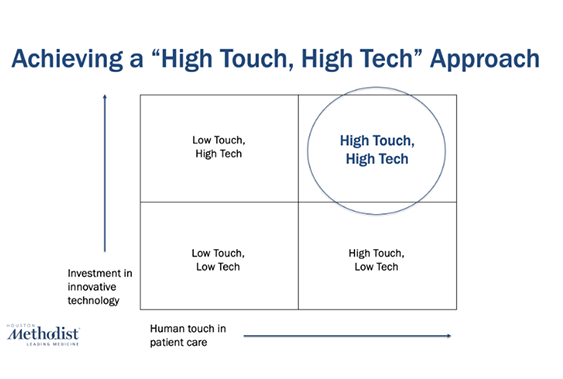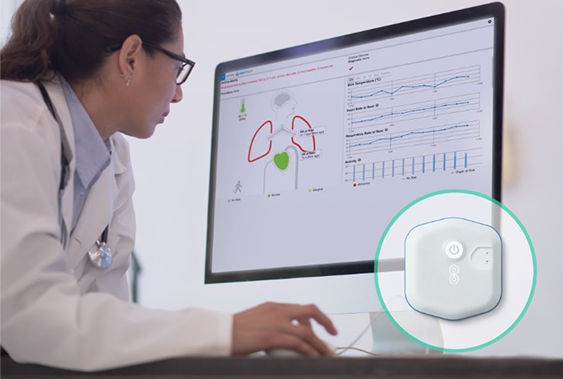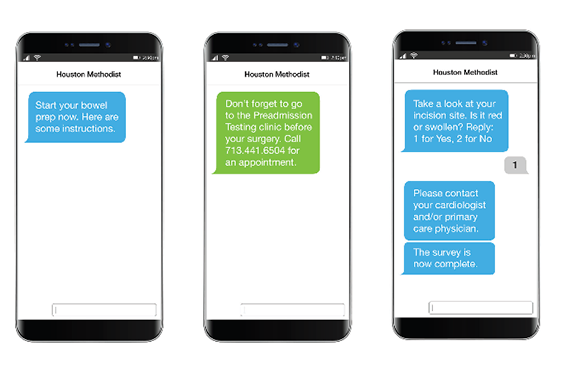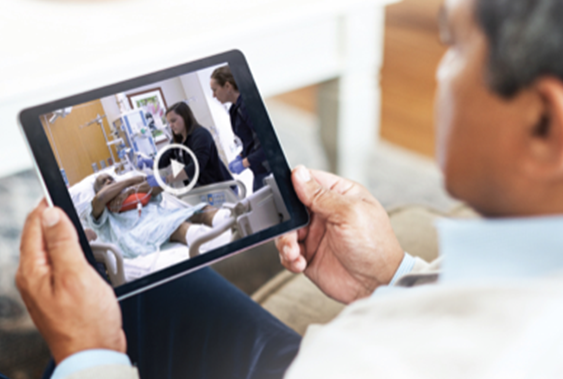High Touch, High Tech: Patients’ Experiences at Houston Methodist
Following are insights published in Houston Methodist’s digital innovation newsletter on LinkedIn by Ashleigh Kamencik-Wright, MBA, BSN, RN and Terrell Williams, MS, MPH, about our use of innovative technologies to improve patient care and the patient experience.
At Houston Methodist, we’re not just adopting technology — we’re transforming how it serves people. This approach to technology is rooted in a systemic belief that innovation should always be personalized and empathetic. Every technological advancement that we adopt must reflect our I CARE values: Integrity, Compassion, Accountability, Respect and Excellence.
As health care leaders focused on system-wide patient experience, we’ve had the privilege of working alongside teams who are deeply committed to a shared vision: delivering care that is both technologically advanced and profoundly human. This approach is the essence of our “High Touch, High Tech” philosophy, a shared commitment at Houston Methodist. It’s not about choosing between innovation and empathy; it’s about designing systems where the two are intrinsically linked.


Our innovation adoption journey begins with a question for every technology considered: How can technology make care more personalized, not less?
Through the Center for Innovation, Houston Methodist brings together hospital operations leaders, clinicians, IT experts and patient experience personnel to implement solutions that are as compassionate as they are cutting-edge. These aren’t just pilots — they’re purpose-driven partnerships that put patients at the center of every decision. We’re not innovating for the sake of novelty. We’re innovating to solve real operational, clinical or patient problems, like reducing patient anxiety before surgery, improving clinician-patient communication during recovery and ensuring that no patient ever feels alone in their journey. One patient commented, “[Houston] Methodist is the perfect example of how a hospital should communicate to connect.”
One of the most impactful tools we’ve implemented is a wearable remote monitoring device that continuously tracks vital signs and transmits real-time data to our care teams. It’s a powerful example of how remote monitoring can extend our safety reach while preserving peace of mind for patients and allowing them to rest while they are in the hospital with fewer interruptions from staff. Patients have shared that wearing this device made them “glad to be being monitored while sleeping” and “watched over without being watched,” highlighting how discreet technology can foster a sense of safety and trust. Clinicians, in turn, report improved response times and earlier detection of complications, reinforcing the device’s dual benefit of enhancing both care quality and emotional reassurance.

We’ve also scaled virtual care across the system, including a robust Virtual ICU and telehealth service that reduces barriers to access and provides patients with 1:1 time with a virtual nurse during admission and discharge. These platforms are efficient, yes — but more importantly, they’re helping us meet patients where they are and allowing us to spend as much time with them as they need. Our virtual urgent care and two-way audio-visual platforms have enabled real-time triage and proactive rounding, reducing wait times and improving satisfaction scores. Patients consistently report that their virtual appointments are smooth, timely and convenient. Many patients and families highlight the relief of avoiding long waits or the comfort of receiving care from home. These platforms are designed to be intuitive and accessible, allowing patients to connect with clinicians in just a few clicks. Even without stepping into a clinic, they feel seen, heard and cared for. These seamless experiences reflect our commitment to equity, access and meeting patients where they are, both physically and emotionally. As one patient put it, “I didn’t feel the need to bug the nurse and doctors.” Another shared, “I called you less because of this,” and a third appreciated not having to “be put on hold forever or transferred to Never-Never Land.” These voices speak volumes about the impact of virtual care — not just in convenience, but in restoring trust and comfort in the health care journey.
And then there’s our Digital Care Pathways — personalized, automated communication journeys that guide and educate patients before and through surgery or procedures, while in the hospital, during recovery — and beyond. These messages aren’t just reminders; they’re touch points of reassurance, clarity and care. Patients have told us they feel “less alone” and “more informed” and that’s exactly the kind of impact we strive for. Our Digital Care Pathways platform has achieved an 80% engagement rate and a 98% satisfaction score. These numbers matter. But what matters more is what they represent: a system that listens, responds and supports. Many patients and family members have expressed appreciation for the clarity, timeliness and consistency of these messages, noting how they help both them and their loved ones stay updated and confident throughout the care journey. It’s a digital solution that strengthens human connection, one message at a time.

One family member shared: “It’s been a scary time for my mother and me because she is very sick, but your team is making things better and tolerable. The charge nurse, the aides — everyone has been kind and patient. I like the texts about timing, tests and medications. The virtual admission team is nice and patient!” Another commented: “You’ve built a wonderful, informative system. You kept us updated on what was happening, where the patient was, even his mood. It relieved our stress and anxiety.” And another added: “I knew I didn’t have to stay at the hospital all the time… Houston Methodist would keep me posted if his condition changed. I liked knowing what was happening when I wasn’t there. Reassuring.” And one patient simply put it: “When released, nurses took excellent care of me through text messages. Houston Methodist West — best hospital ever.”
We’re also reimagining multidisciplinary rounds, integrating digital tools that enhance collaboration while keeping the patient at the center of every conversation. These moments — where nurses, physicians, case managers and patient experience leaders come together — are where high touch meets high tech in its purest form. Clinicians and staff have shared that they find our digital rounding tools make patient-clinician conversations feel more focused, inclusive and efficient. These tools also allow for real-time documentation, which improves the continuity of care and ensures that patients are truly heard. Patients have noticed the difference. One shared, “I was impressed that six people came to my room prepared to discuss my situation and explain their plan.” Another said, “The physician care team collaborated and visited with me daily.” And another added, “Staff made me feel like I was their only patient.” One patient also highlighted the strength of team communication: “I also like the communication device where they could get in touch with each other. I was impressed by the teamwork and how well they worked together.” These reflections speak to the power of coordinated, compassionate care — supported by technology, but driven by human connection. It’s not just about rounding; it’s about reinforcing trust, transparency, and teamwork at every step of the patient journey.

At Houston Methodist, we’re not just building the hospitals of the future — we’re building a future where technology amplifies humanity. Every innovation we adopt is evaluated through the lens of dignity, trust and emotional resonance. We ask: “Will this make our patients feel more confident? More connected? More cared for?” We believe that innovation should never come at the expense of compassion. Instead, it should deepen our ability to connect, to understand and to heal. Technology doesn’t replace the human touch — it amplifies it. And that’s what makes our model not just innovative, but truly transformational. As the technology evolves, so does our commitment to care. Guided by our I CARE values, we will continue to ensure that every innovation serves a deeper purpose: making patients feel truly seen, heard and respected.
